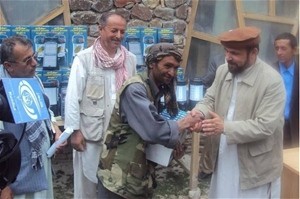
Badakhshan Governor Shah Wali Adeeb presents a lantern to a recipient, while Eng. Pir Mohammad Yaftali, MRRD Director for Badakhshan, looks on.
Jon Nyswonger/USAID
Replacing expensive, unsafe, and unhealthy kerosene lamps with safe, renewable solar lanterns
5 AUGUST 2011 | BADAKHSHAN, AFGHANISTAN
The Wakhan corridor is a remote mountainous part of the Pamir region of Afghanistan that connects the country with China. The semi-nomadic Kyrgyz and Wakhi peoples populate this rugged landscape. They practice agriculture in the river valleys and herd animals in the summer pastures at high elevations. With funding from USAID, the Wildlife Conservation Society (WCS) has been working with these local indigenous communities to ensure the survival of the local fauna, including snow leopards, Marco Polo sheep, wolves, and eagles.
As part of these conservation efforts, WCS has created a local wildlife conservation association. USAID recently joined forces with WCS in providing an incentive for local villagers to join the conservation society. As part of their membership package, they are provided with a solar-powered LED lantern. WCS distributed 1,620 solar lanterns in June 2011 to the same number of Wakhi and Kyrgyz households.
The distribution was held in the Wakhan district center of Qala-e-Panja and was conducted by Governor of Badakhshan Shah Wali Adeeb, and representatives of WCS and the Ministry for Rehabilitation and Rural Development. The solar lanterns, which were provided through USAID, were the first of 7,000 lanterns that are being distributed to rural villages in the provinces of Badakhshan, Bamyan, and Khost through USAID’s partners WCS and MRRD.
The lanterns consist of a 2.3 watt solar cell, a six volt sealed lead-acid battery that can provide light for up to 20 hours, and 16 high-intensity LED bulbs that create a strong light capable of illuminating an entire room.
The atmosphere at the lantern distribution was festive, and the response from those receiving lanterns was overwhelmingly positive.
Murad Mohamad, one of the beneficiaries, said, “Till now I’ve been using kerosene lanterns. Sometimes we could find fuel, but some-times we couldn’t. When we ran out of kerosene, I’d travel long distances to find some. While I was away, my children were unable to study because there’s no power in this area. This is really a good thing, and it shows that the government is paying attention to us.”







Comment
Make a general inquiry or suggest an improvement.